E-commerce businesses face unprecedented competition, with over 26 million online stores worldwide competing for consumer attention. For these digital retailers, achieving visibility in search results isn't just important—it's essential for survival. However, optimizing thousands of product pages, managing complex technical requirements, and staying ahead of algorithm changes can overwhelm even the most resourceful businesses.
This challenge creates a significant opportunity for marketing agencies looking to expand their service offerings. White label SEO partnerships allow agencies to deliver comprehensive search optimization services to e-commerce clients without the need to build extensive in-house expertise or handle the operational burden internally.
The statistics tell a compelling story: 68% of online experiences begin with a search engine, and e-commerce businesses that invest in SEO see an average conversion rate of 14.6%—significantly higher than traditional advertising methods.
For agencies, the white label SEO market has grown by 23% annually, with e-commerce representing the fastest-growing segment.
This comprehensive guide explores how agencies can leverage white label SEO partnerships to serve e-commerce clients effectively, covering everything from understanding unique e-commerce challenges to implementing scalable solutions and avoiding costly mistakes.
Why E-Commerce SEO Is Unique?
Unlike brick-and-mortar businesses, e-commerce clients often compete nationally or globally. They deal with large product catalogs, dynamic content, and ever-changing inventory. That means SEO strategies need to be highly technical and tailored, with a strong focus on:
- Product and Category Page Optimization
- Schema Markup and Structured Data for Rich Results
- Site Speed and Mobile Responsiveness
- Internal Linking and Crawlability
- Content and Backlink Scalability Across Hundreds or Thousands of SKUs
This level of complexity is difficult to scale without the right SEO tools and systems — which is exactly where white-label SEO solutions come in.
Why White Label SEO is a Game-Changer for E-Commerce Clients?
E-commerce SEO presents unique complexities that traditional website optimization simply doesn't address. Consider a mid-sized online retailer with 10,000 products across multiple categories. Each product page requires individual optimization, while category pages need strategic keyword targeting, and the entire site architecture must support both user experience and search engine crawling.
The scale alone makes in-house SEO management challenging. Most e-commerce businesses lack the specialized knowledge needed to handle technical issues like pagination, faceted navigation, or product schema markup. Additionally, they need ongoing content creation, link-building strategies tailored to commerce sites, and constant monitoring of competitor activities.
White label SEO partnerships solve these challenges by providing agencies with access to specialized e-commerce expertise without the overhead costs. According to recent industry data, agencies using white label services can increase their service capacity by 300% while maintaining profit margins of 40-60%.
The competitive advantages are substantial. Speed-to-market becomes crucial when e-commerce clients need immediate results during peak shopping seasons. A white label partnership allows agencies to launch comprehensive SEO campaigns within weeks rather than months. Cost efficiency follows naturally—rather than hiring and training specialized staff, agencies can access expert-level services on demand.
Perhaps most importantly, white label SEO agency provide depth of expertise that would be impossible to maintain in-house. E-commerce SEO requires knowledge of platform-specific optimization (Shopify, Magento, WooCommerce), understanding of consumer search behavior, and familiarity with e-commerce-specific ranking factors.
Unique SEO Challenges for E-Commerce Clients
E-commerce websites face SEO challenges that don't exist in other industries, requiring specialized approaches and expertise to overcome effectively.
1. Duplicate Content Across Product Variations
One of the most persistent issues in e-commerce SEO involves managing duplicate content created by product variations. When a single product comes in multiple colors, sizes, or configurations, many platforms automatically generate separate URLs for each variation. This can result in dozens of nearly identical pages competing against each other in search results.
The solution requires strategic use of canonical tags, proper URL parameter handling, and careful consideration of which variations deserve individual optimization versus consolidation.
2. Technical SEO for Large Product Catalogs
Large e-commerce sites often struggle with crawl budget optimization and indexing issues. Search engines have limited resources to crawl any single website, and when faced with thousands of product pages, they must prioritize which pages receive attention.
Pagination presents another technical challenge. Category pages with hundreds of products require a careful pagination strategy to ensure all products remain discoverable while avoiding thin content penalties. Faceted navigation—allowing customers to filter by price, brand, color, or other attributes—can create thousands of low-value pages that dilute SEO efforts.
3. Mobile-First Performance and Core Web Vitals
E-commerce sites typically include numerous product images, customer reviews, and dynamic elements that can slow page loading times. With mobile commerce representing over 54% of all e-commerce traffic, page speed optimization becomes critical for both user experience and search rankings.
Core Web Vitals - Google's user experience metrics—particularly impact e-commerce sites. Loading speed, interactivity, and visual stability directly influence conversion rates. Studies show that a one-second delay in page load time can reduce conversions by 7%.
4. Complex Site Architecture and Internal Linking
E-commerce sites require sophisticated information architecture to balance user navigation with SEO requirements. The relationship between category pages, subcategory pages, product pages, and supporting content must be carefully structured to distribute link equity effectively while maintaining logical user paths.
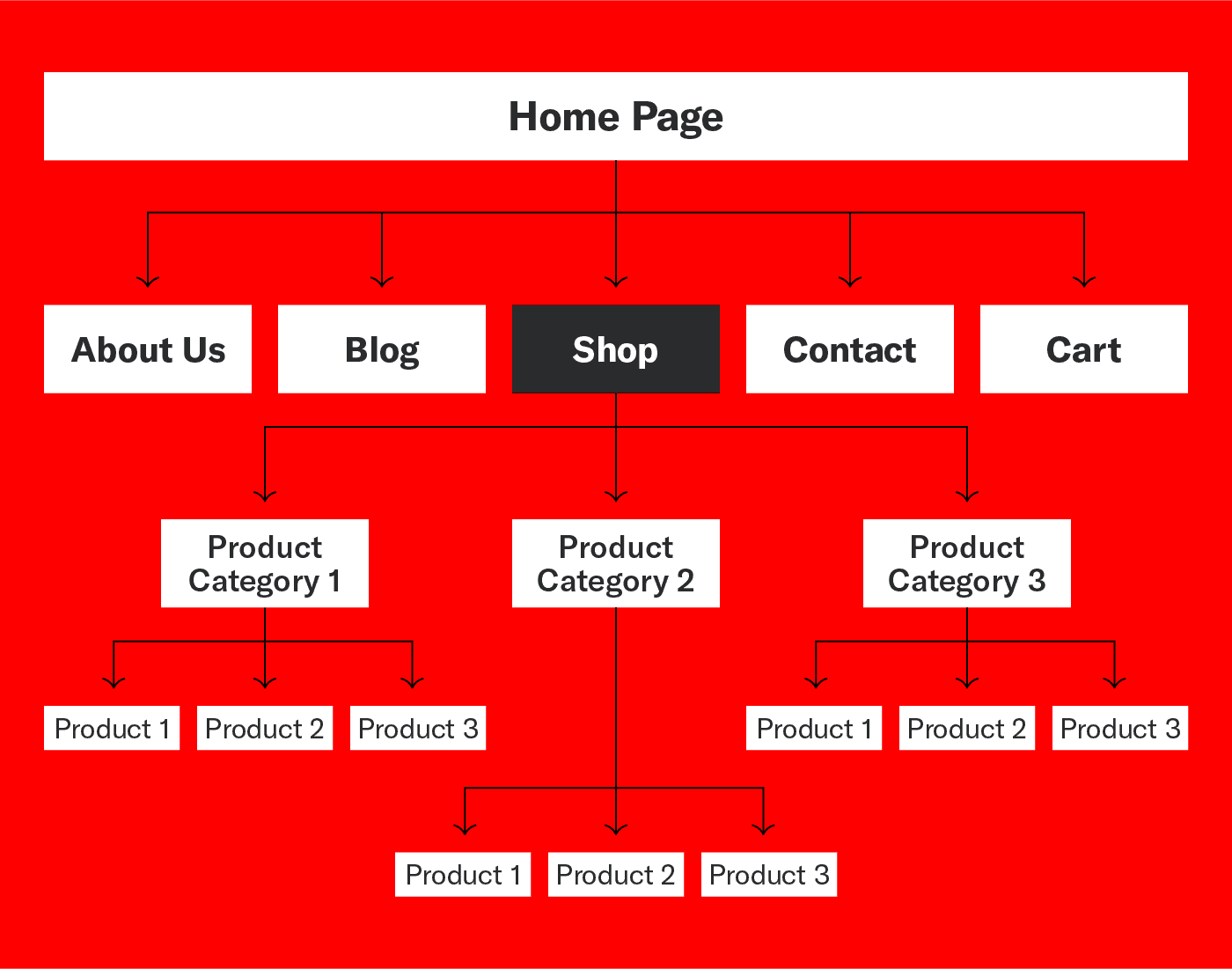
Image Source: SiegeMedia
Internal linking strategies become more complex when dealing with seasonal products, inventory changes, and promotional campaigns that temporarily alter site structure.
5. Multi-Market and Local SEO Integration
Many e-commerce businesses serve multiple geographic markets, each with unique search behaviors, seasonal patterns, and competitive landscapes. International SEO requires managing multiple language versions, currency options, and region-specific product availability while avoiding duplicate content penalties.
For businesses with physical locations, integrating local SEO elements like store locators and Google Business Profiles adds another layer of complexity.
6. E-E-A-T and Trust Signals for Commerce
Google's E-E-A-T guidelines (Experience, Expertise, Authoritativeness, Trustworthiness) apply particularly strongly to e-commerce sites handling financial transactions. Product reviews, security certifications, clear return policies, and transparent business information all contribute to trustworthiness signals that influence search rankings.
Building these trust elements requires coordinated efforts across content creation, technical implementation, and user experience design.
Core Elements of White Label SEO for E-Commerce
Successful white label SEO for e-commerce requires a systematic approach that addresses both technical foundation and ongoing optimization needs.
1. Comprehensive E-Commerce Site Audits
E-commerce audits must go beyond standard SEO analysis to include commerce-specific elements. Technical audits should examine product page templates, category page structure, checkout process optimization, and mobile commerce functionality. Content audits need to evaluate product descriptions, category page content, and supporting materials like buying guides and FAQ sections.
A thorough audit also examines competitive positioning within specific product categories, seasonal search pattern analysis, and identification of high-value keywords that competitors may be overlooking.
2. Keyword Research at E-Commerce Scale
E-commerce keyword research operates on multiple levels simultaneously. Category-level keywords capture broader search intent, while product-specific long-tail keywords target users ready to purchase. The research must also account for seasonal variations, trending products, and emerging market opportunities.
Effective keyword strategies include identifying product comparison terms, problem-solving keywords that lead to product discovery, and brand-related searches that indicate higher purchase intent.
3. Product Page and Schema Optimization
Each product page requires individual optimization while maintaining template consistency. This includes unique product descriptions that avoid manufacturer content duplication, strategic keyword placement that feels natural, and comprehensive schema markup that helps search engines understand product details, pricing, availability, and review information.
Category pages need similar attention, with optimized descriptions that provide value beyond simple product listings and internal linking strategies that support both user navigation and SEO objectives.
4. Technical Infrastructure Optimization
E-commerce technical SEO requires specialized knowledge of commerce platforms and their unique challenges. This includes optimizing URL structures for product variations, implementing proper canonical tag strategies, managing pagination and filtering systems, and ensuring mobile performance meets modern standards.
Structured data implementation becomes particularly important for e-commerce sites, as rich snippets for products, reviews, and business information can significantly improve click-through rates from search results.
5. Commerce-Focused Content Marketing
Content marketing for e-commerce extends beyond traditional blog posts to include buying guides, product comparison articles, how-to content, and seasonal shopping advice. This content must be strategically linked to relevant product and category pages while providing genuine value to potential customers.
FAQ sections, size guides, and how-to content serve dual purposes of improving user experience and capturing long-tail search traffic. This content often ranks more easily than competitive product pages while building topical authority.
6. Strategic Link Building for E-Commerce
Link building for e-commerce requires different approaches than service-based businesses. Opportunities include product reviews from industry publications, partnerships with complementary businesses, participation in industry trade publications, and creating linkable assets like industry reports or trend analyses.
DashClicks offers specialized white label backlinks services in link building strategies, helping agencies deliver comprehensive campaigns that drive both authority and targeted traffic to client sites.
7. Local SEO Integration
Implementing strong local SEO practices is essential for driving foot traffic and achieving visibility in local search results. One core strategy involves integrating store locators into your website. These tools provide users with an easy way to find their nearest location, offering details such as directions, contact information, and operating hours. Optimizing these pages with local keywords, structured data, and user-friendly design enhances their visibility in search engines.
Additionally, leveraging Google Business Profile ensures your business appears prominently in local search results and Google Maps. By maintaining accurate and up-to-date information—such as business Name, Address, Phone Number (NAP), and customer reviews—you increase your chances of ranking higher in local search.
Regular updates, engaging posts, and leveraging features like Q&A and photos strengthen online presence while building trust with potential customers. Combined, these tactics maximize local search visibility and drive both online and offline conversions.
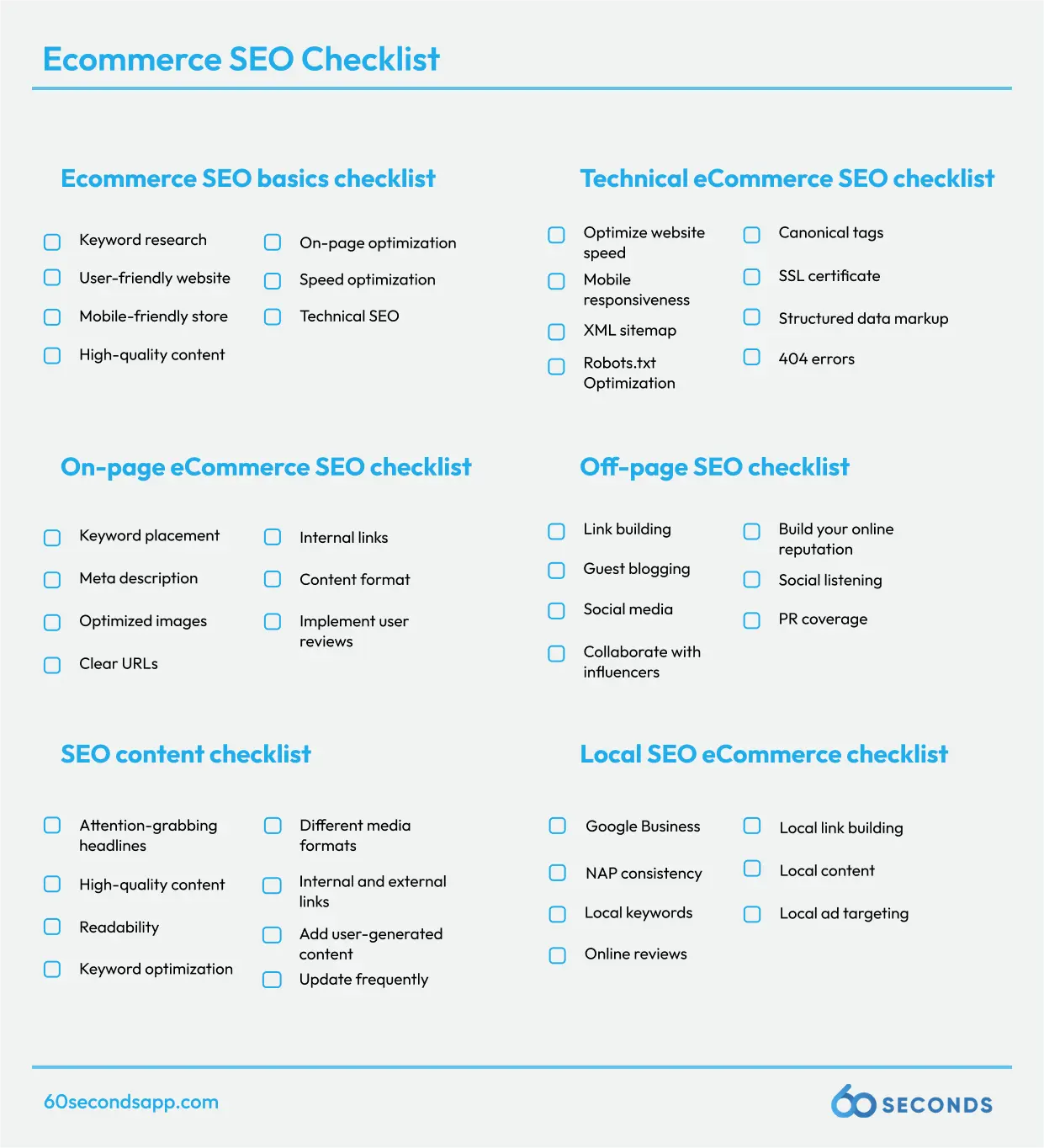
Image Source: 60seconds
Best Practices for White Label SEO Implementation
Maximizing the value of white label SEO partnerships requires strategic planning and clear communication protocols.
1. Understanding Client Needs and Market Positioning
Before engaging white label SEO services, agencies must thoroughly understand each client's unique market position, target audience demographics, and business objectives. E-commerce clients may prioritize different metrics—some focus on overall traffic growth, others on specific category rankings, and many need support for seasonal campaigns or new product launches.
Understanding the client's target audience allows for more precise keyword targeting and content strategies. Regional preferences, seasonal shopping patterns, and competitive landscape analysis all inform the strategic approach.
2. Choosing Performance Metrics That Matter
E-commerce SEO success requires tracking metrics that directly correlate with business outcomes. While traditional metrics like keyword rankings and organic traffic remain important, e-commerce clients need visibility into conversion-focused measurements.
Key metrics include organic revenue growth, product page conversion rates, category page performance, and seasonal trend analysis. Advanced tracking should measure the customer journey from initial search through purchase completion, identifying optimization opportunities at each stage.
Data transparency becomes crucial for maintaining client relationships. White label SEO partner should offer detailed reporting that agencies can brand and present to clients with confidence.
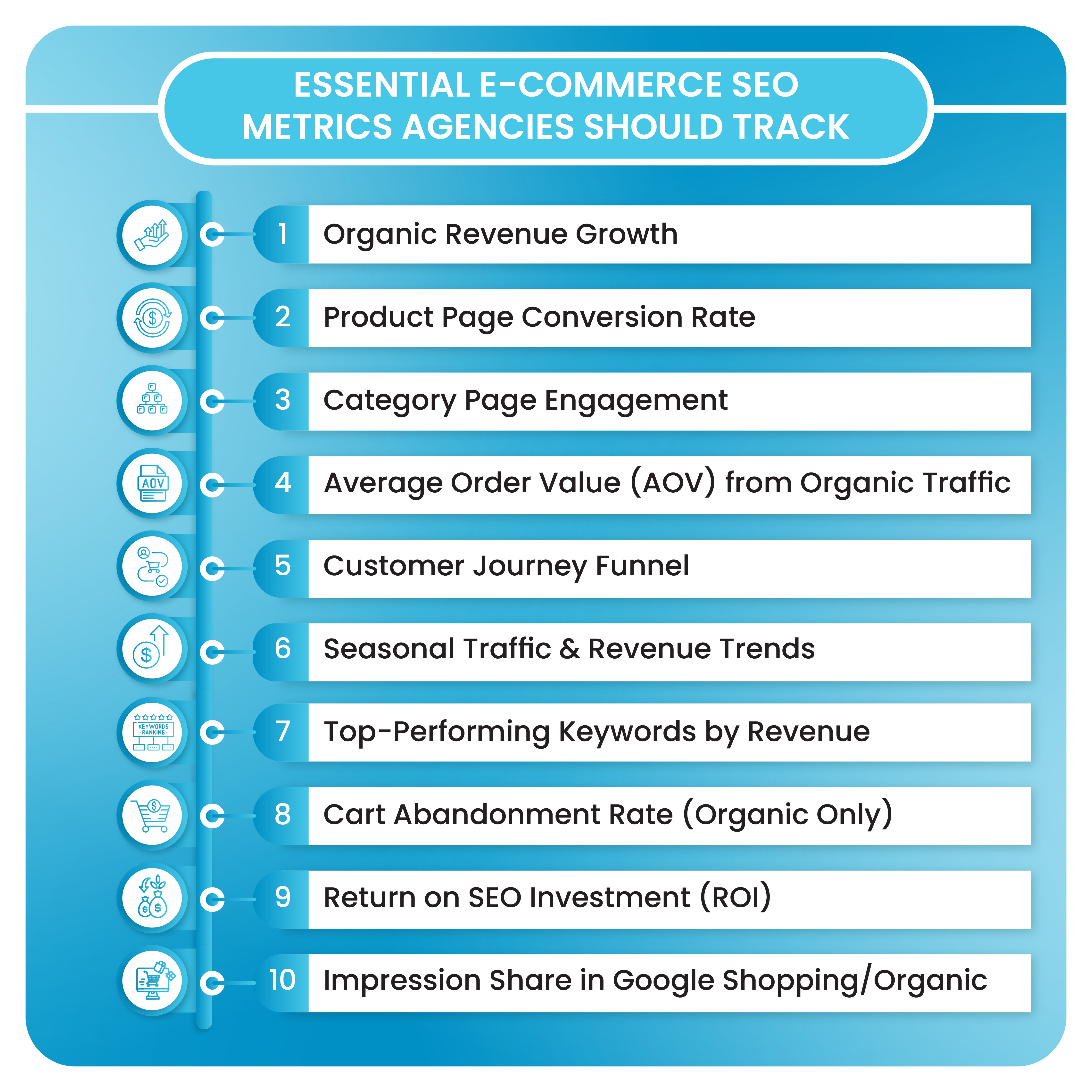
3. Prioritizing Technical Foundation
E-commerce sites require solid technical foundations before content and link building efforts can achieve maximum impact. Site speed optimization, mobile performance, and structured data implementation often provide immediate improvements in search visibility and user experience.
The technical audit and optimization phase should address crawl budget optimization, duplicate content issues, and conversion rate optimization elements that support SEO objectives.
4. Establishing Clear Communication Protocols
Successful white label partnerships require clear communication channels and regular review cycles. Agencies should establish protocols for client feedback integration, campaign adjustments, and performance reporting.
Regular communication ensures that white label providers understand client brand guidelines, seasonal priorities, and any business changes that might impact SEO strategy. This includes inventory changes, new product launches, promotional campaigns, and market expansion plans.
DashClicks facilitates this communication through comprehensive project management software and branded reporting dashboards that maintain the agency-client relationship while ensuring quality service delivery.
Action Plan to Get Started With White Label SEO Services
Step 1: Define Clear Objectives
Identify specific business outcomes, including organic revenue targets, traffic growth goals, and market expansion objectives. Set measurable KPIs including organic conversion rates, category page rankings, and return on advertising spend from organic channels.
Prioritize clients requiring immediate SEO support while developing systematic approaches for scaling services across larger client portfolios.
Step 2: Research Qualified Partners
Evaluate white label SEO providers based on e-commerce platform expertise, case study results, and scalability potential. Review client testimonials, sample deliverables, and pricing models that align with agency profit margins.
Verify provider experience with relevant e-commerce platforms and their understanding of industry-specific challenges like seasonal fluctuations and product catalog management.
Step 3: Conduct Comprehensive Audits
Perform technical assessments covering site speed, mobile usability, and crawl error identification. Analyze existing content quality, keyword targeting effectiveness, and competitive positioning across product categories.
Review current link profiles, identify optimization opportunities, and benchmark performance against direct competitors to establish improvement potential.
Step 4: Establish Service Frameworks
Define service scope including audit frequency, content deliverables, technical implementations, and link-building strategies. Create white-labeled reporting dashboards that maintain agency branding while providing client transparency.
Agree on communication schedules, review processes, and escalation procedures that ensure consistent service quality across all client relationships.
Step 5: Create Seamless Onboarding
Document brand guidelines, tone requirements, and client-specific considerations for white label partners. Share detailed client expectations and establish communication protocols that maintain professional relationships.
Develop automation tools and templates that streamline client handoff processes while ensuring all necessary information transfers accurately.

Step 6: Launch Pilot Campaigns
Begin with one or two clients to test workflows, communication processes, and service quality before scaling operations. Monitor early results including ranking improvements, traffic growth, and conversion rate changes.
Use pilot campaign data to refine processes, adjust service offerings, and optimize client communication approaches for broader implementation.
Step 7: Scale Operations Strategically
Gradually expand client portfolios as processes stabilize and prove effective. Regularly review partnership ROI, profit margins, and client satisfaction metrics to ensure sustainable growth.
Incorporate advanced strategies like schema markup optimization, voice search preparation, and artificial intelligence integration as client needs evolve.
Step 8: Monitor and Optimize Continuously
Implement quality control systems that prevent duplicate content issues, link spam, and other problems that could damage client websites. Ensure transparent reporting maintains client trust while demonstrating measurable value.
Stay current with algorithm updates, industry trends, and e-commerce platform changes that affect optimization strategies and client results.
Common Pitfalls and How to Avoid Them
1. Quality Control Failures
Poor-quality backlinks or substandard content can damage client websites and agency reputations simultaneously. Choosing white label SEO partner thoroughly includes reviewing case studies, checking references, and evaluating sample deliverables before committing to partnerships.
Regular quality audits of delivered work help identify issues before they impact client results. Establishing clear quality standards and review processes protects both agency and client interests.
2. Neglecting Long-Tail Opportunities
Generic keyword targeting often overlooks high-converting long-tail opportunities that drive e-commerce revenue. Terms like "best portable bluetooth speakers" may have lower search volumes but significantly higher conversion potential than broad category terms.
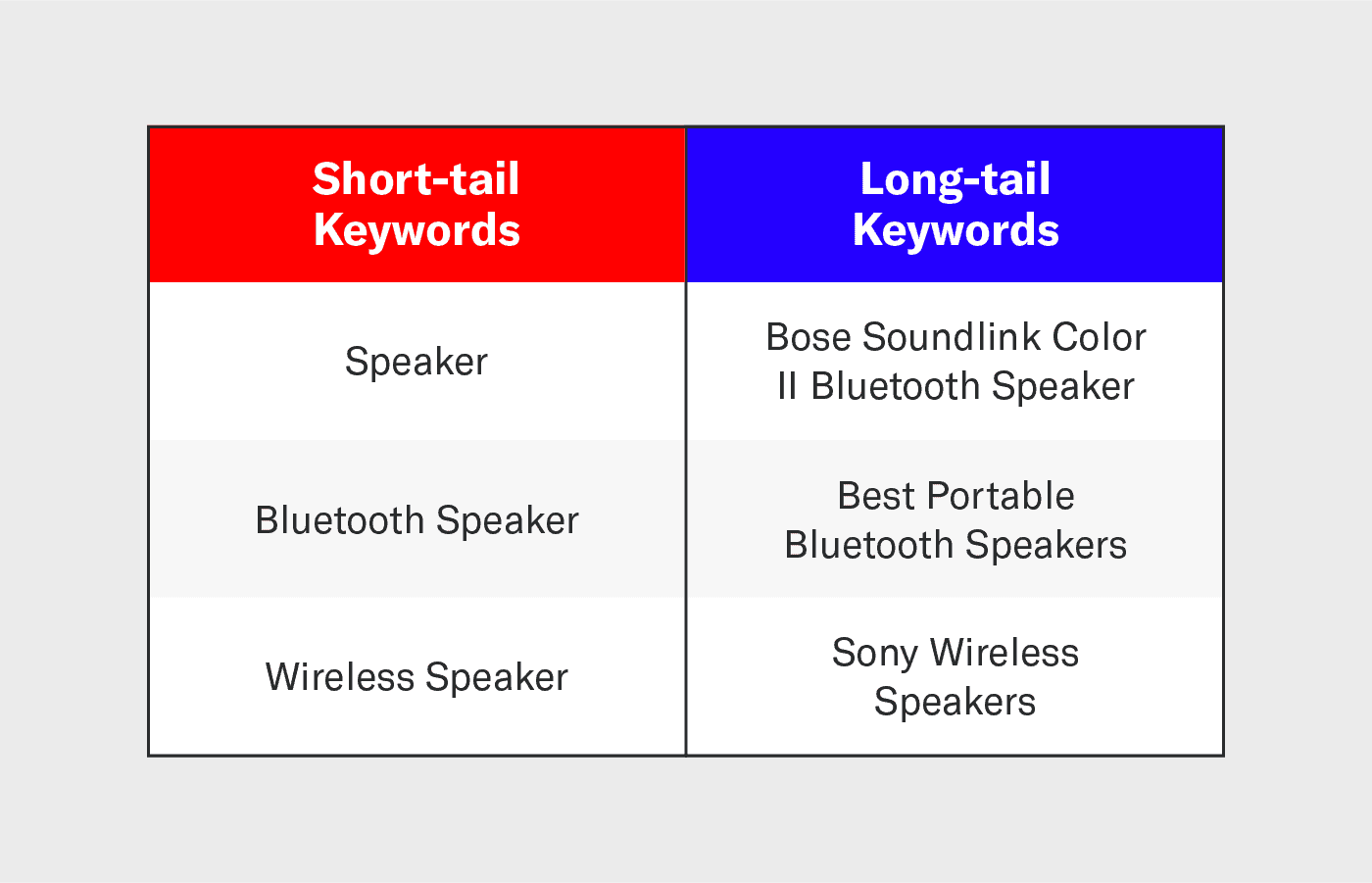
Image Source: SiegeMedia
Comprehensive keyword research should identify opportunities across the entire purchase funnel, from broad awareness terms to specific product queries that indicate strong purchase intent.
3. Overlooking Local SEO Integration
Multi-location retailers require coordinated local SEO strategies that complement broader e-commerce optimization efforts. Google Business Profile optimization, local citation management, and location-specific content creation become essential for businesses serving local markets.
Ignoring local search opportunities can result in lost revenue from nearby customers who prefer shopping with local businesses or visiting physical stores before purchasing.
4. Technical Oversight Gaps
Site speed issues, mobile performance problems, and structured data errors can undermine even excellent content and link building strategies. Regular technical monitoring helps identify and resolve issues before they impact search performance significantly.
Core Web Vitals monitoring becomes particularly important for e-commerce sites where page load speeds directly impact conversion rates and customer satisfaction.
5. Insufficient Conversion Tracking
Ranking improvements without corresponding revenue growth indicate strategic misalignment. Comprehensive tracking should connect organic search traffic to actual sales outcomes, enabling data-driven optimization decisions.
Analytics implementation should track the complete customer journey from search query to purchase completion, identifying opportunities to improve conversion rates alongside traffic growth.
6. Ignoring E-Commerce Evolution
Voice search optimization, artificial intelligence integration, and zero-click search results represent emerging trends that impact e-commerce SEO strategies. Staying current with industry developments ensures long-term campaign effectiveness.
Regular strategy reviews should incorporate new search features, algorithm updates, and consumer behavior changes that affect e-commerce search performance.
How Agencies Can Win With White-Label SEO Services from DashClicks?
Managing SEO for e-commerce brands requires more than just keywords and backlinks — it demands agility, precision, and scalable systems. For agencies serving online retailers, offering white label SEO can be a powerful growth strategy, enabling you to deliver high-impact results without expanding your in-house team. But it comes with its own set of best practices — and potential pitfalls.
How DashClicks Powers E-Commerce SEO at Scale?
Here’s what you need to know to succeed, and how DashClicks can be the game-changer that transforms your e-commerce SEO offerings.
DashClicks offers a full suite of white label SEO services designed specifically to meet the challenges of modern e-commerce. Their platform includes:
- A fully branded client dashboard for transparent communication and reporting.
- Scalable, on-demand SEO fulfillment done by experts.
- In-depth technical audits to fix backend issues affecting rankings.
- Smart tools like InstaReports, Analytics, and SEO Campaign Manager to streamline your operations and impress clients.
- White-label local SEO, backlink services, and content creation — all tailored to e-commerce SEO needs.
For digital agencies, DashClicks isn’t just a tool — it’s an operations engine. By automating fulfillment, reporting, and client communication, DashClicks frees up your team to focus on strategy and client growth. It enables even small agencies to deliver enterprise-level results with confidence and consistency.
Conclusion
White label SEO partnerships offer agencies scalable solutions for serving e-commerce clients effectively without developing specialized expertise internally. Success requires careful partner selection, clear communication protocols, and systematic quality control processes.
The e-commerce landscape continues evolving with new technologies, consumer behaviors, and search engine features. Agencies that establish strong white label relationships while maintaining focus on client outcomes position themselves for sustained growth.
Research potential partners thoroughly, understand client needs comprehensively, and implement systematic approaches to quality control. The right partnerships can transform agency capabilities while delivering exceptional results for e-commerce clients.
Choose partners wisely, monitor results consistently, and adapt strategies based on performance data and industry evolution.
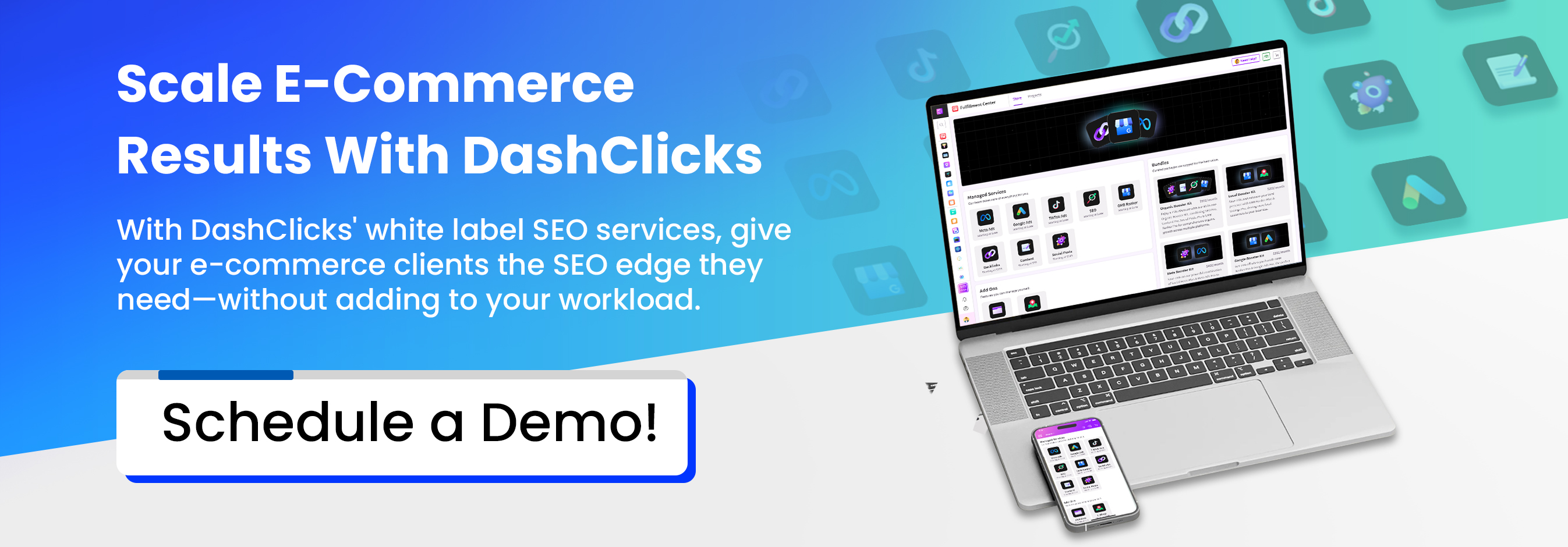


.svg)

.svg)
.svg)
.svg)
.svg)
.svg)
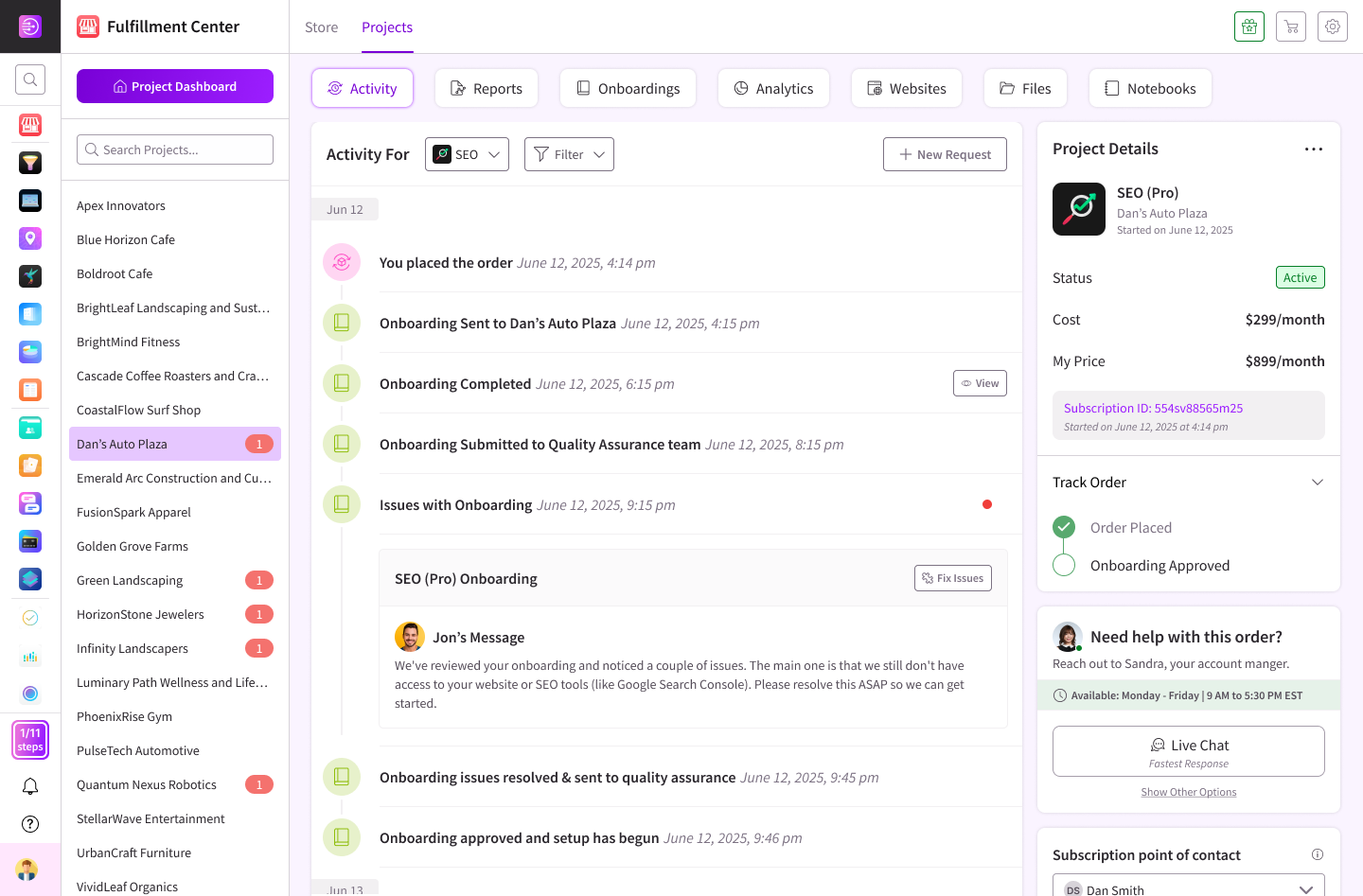
.svg)




.svg)
.svg)
.svg)
.svg)
.svg)